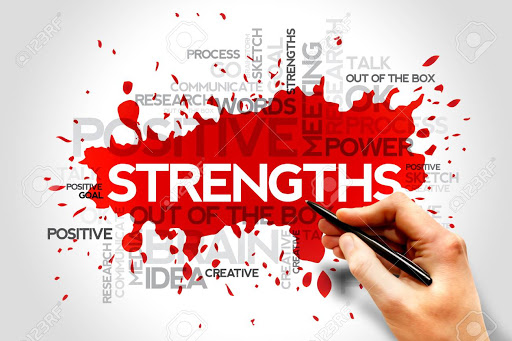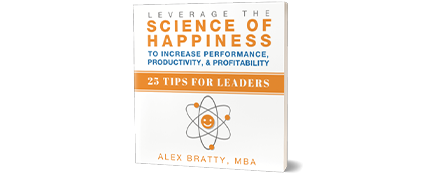We’re all familiar with the traditional performance review where “areas of improvement” are identified for team members to work on.
Makes sense—we all have strengths and weaknesses. Conventional wisdom is that we need to work on our weaknesses. But, what if that’s not true? What if it’s actually better to focus on your strengths?
Think about that for a moment…
If you were coaching an Olympic athlete whose specialty event was the 100 meters, would you recommend that she work on building up her long-distance endurance so she can get better at her area of weakness, the 800 meters? Of course not! You’d be focused on developing what makes her great at the 100 meters so she can be even better.
Guess what? The same thing is true in business. As a leader or manager, you are effectively a coach for your people. Think of yourself as the Olympic coach who develops their strengths.
And, here’s why this matters so much. Research shows that using our top strengths at work is associated with greater:
- Engagement
- Productivity
- Satisfaction
- Perceiving work-as-a-calling
- Financial success
As a positive leader, all of that evidence should be ringing your bell.
Okay, so how do we actually implement a strengths-based approach in the workplace?
Well, first you need to identify your strengths by taking a simple assessment. Yes, even if you think you know your strengths, you should still take the assessment because most of us are blind to many of our strengths. So, the assessment helps us to see our strengths more clearly.
There are different assessments you can use for this and if you want more on that, check out this previous post. My preferred assessment is the VIA Character Strengths assessment. You can take this assessment for free at my website – just go to http://www.happinessatworknow.com/survey. It takes about 15 minutes to complete and I assure you the questions are simple and easy.
The reason I like this assessment so much is that it’s evidence-based and has been open to years of peer-review and refinement. It was developed about 20 years ago from the work of 50+ scientists who examined all the literature that exists on virtue and character. From the ancient philosophers to religious scriptures to literature across all cultures—it took them 3 years to do this. What they found is that there are 24 character strengths that are universal.
Universal in 2 ways.
First, they are universal in the sense that they are recognized and valued around the world and across all cultures and religions.
Second, they are universal in the sense that we all have each of these 24 character strengths within us, but each of us has a different combination. So, when you take the assessment you get your personal ranking of these 24 strengths.
Now, one really important thought to keep in mind—every single item on your list is a strength. Nearly always, people get their ranking and immediately look at the bottom to identify their weaknesses. These are not weaknesses. They’re simply strengths that you either don’t use as much or don’t connect with as closely as your other higher-ranking strengths.
Plus, here’s the other cool feature of this assessment. Unlike other assessments that might focus only on work strengths, the character strengths apply to every facet of your life. So, yes, they’re great for the workplace, and you’ll also be able to leverage them in other areas, too.
Okay, so now you know have a little context on character strengths, here’s what to do:
- You and your team take the assessment to identify strengths. You can do that for free at my website: http://www.happinessatworknow.com/survey
- Convene your team and have people share their results and reactions. If you have a large team, simply create some small break-out groups for this discussion, and then bring them back together for an overall review.
- Have your employees pin up their top strengths in clear view of others in the office. If you have remote workers, have them add their top strengths to their email signature or project software handle. The point is to have people start thinking about these strengths and becoming aware of their colleagues’ strengths.
- Next, use a simple strategy to integrate everyone’s strengths and create a strengths-based workplace. This 4-week plan was developed by Dr. Ryan Niemiec and Dr. Robert McGrath, the experts who helped to develop the VIA character strengths assessment. You can read more about it in their most excellent book: The Power of Character Strengths.
Week 1: Have people spot and appreciate when others are using strengths. It’s much easier to see strengths use in others than in ourselves. So, this is a great way to have people thinking about strengths. Plus, when we call out the use of a strength, it fosters a positive and supportive environment.
Week 2: have people explore and use their top strengths. There are a couple of ways to do this.
- Pick one top strength and use it in a different way each day for a week.
- Pick a different top strength for each day and identify a different way to use it each day for a week.
Need some ideas on how to do this? Check out this helpful resource that will get your creative juices flowing.
Week 3: encourage employees to apply their top strengths to challenges at work, and write down afterwards their experience of this. Did it help them? How did they feel about it?
Week 4: start making strengths use a habit. Have team members write down their goals and identify the strengths that could help them reach those goals. As you do this, people will start to realize that sometimes they need to use combinations of strengths, or that some strengths need to be flexed more than others.
Of course, as you move through this 4-week plan, have a few meetings to review and discuss each step and gather thoughts and reactions from team members.
Prepare to be surprised at just how much this simple process can shift the atmosphere in the workplace, and how people treat each other. A fantastic side-effect of this is that communication improves immensely, because people gain a much better understanding of one another. Now, instead of Sally being the annoying person who always wants to change a project after it’s been settled, people realize that all she’s doing is bringing her strength of creativity to the table. Now that is understood, perhaps Sally’s talents can be directed in a way that leverage this amazing creativity. You get the point. Tapping into strengths changes things for the better in multiple ways. So, be prepared for that.
Okay, so there you have it—how to implement a strengths-based approach in your workplace in a matter of weeks! Remember, to access the free assessment, just go to http://www.happinessatworknow.com/survey. If you want a more comprehensive report that includes various insights on the strengths, you can pay a nominal fee and take the assessment at the VIA Institute on Character website, which is https://www.viacharacter.org/
If you want to share how you’re creating a strengths-based workplace or you have questions on this topic, write to me at [email protected]. I always love to hear from you. 🙂






0 Comments